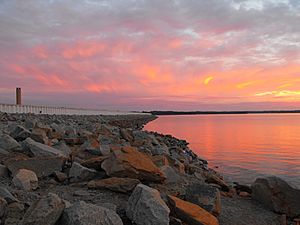Saluda Dam facts for kids
Quick facts for kids Lake Murray Dam |
|
|---|---|

Looking down the dam from the Irmo side.
|
|
| Official name | Dreher Shoals Dam |
| Location | Lexington County, near Lexington, South Carolina |
| Coordinates | 34°03′12″N 81°13′04″W / 34.0533°N 81.2178°W |
| Construction began | 1927 |
| Opening date | 1930 |
| Operator(s) | Dominion Energy |
| Dam and spillways | |
| Type of dam | Embankment, earth-fill with RCC gravity toe |
| Impounds | Saluda River |
| Height | 200 ft (61 m) |
| Length | 7,800 ft (2,400 m) |
| Reservoir | |
| Creates | Lake Murray |
| Total capacity | 2,200,000 acre⋅ft (2.7 km3) |
| Catchment area | 2,420 sq mi (6,300 km2) |
| Surface area | 50,000 acres (200 km2) |
| Power station | |
| Turbines | 5 x vertical Francis turbines (3 @ 32.5 MW, 1 @ 42.3 MW, 1 @ 67.5 MW) |
| Installed capacity | 207 MW |
| Annual generation | 245,000,000 kWh |
The Lake Murray Dam, also known as the Dreher Shoals Dam, is a huge wall of earth built across the Saluda River in South Carolina. It's about 10 miles (15 km) west of Columbia, South Carolina. Workers started building this dam in 1927, and it was finished in 1930.
The dam helps with many things. It controls floods, creates electricity, provides water, and offers a fun place for recreation like boating. When it was built, the Lake Murray Dam was the biggest earthen dam in the world. It also created Lake Murray, which was the largest man-made lake at the time.
In 2005, a new, strong concrete wall was built right in front of the original dam. This new wall is 213 feet (65 meters) tall. It was added to make sure the dam stays safe, even if there's a big earthquake.
South Carolina Highway 6 goes right over the dam. This road is a quick way to travel between the towns of Lexington and Irmo. There's even a fun local tradition: the yearly football game between Lexington High School and Irmo High School is often called "The Battle of the Dam"!
Contents
What Makes the Dam Special?
The original Lake Murray Dam is super long, stretching about 7,800 feet (2,377 meters). It's also very tall, reaching 213 feet (65 meters) high. If the lake gets too full, there's an emergency spillway that's 2,900 feet (884 meters) long. This spillway has six large steel gates that can open to let water out safely.
The newer backup dam, built in front of the original, is made of a special type of concrete. It's 2,300 feet (701 meters) long and also 213 feet (65 meters) high. When you add the rock sections on the ends, the whole backup structure is about 5,700 feet (1,737 meters) long.
How the Dam Makes Electricity
The dam has a power station with five large machines called Francis turbines. These turbines spin to make electricity. Three of them produce 32.5 megawatts each, one makes 42.3 megawatts, and another makes 67.5 megawatts.
Water flows into the power station through five tall towers, each 223 feet (68 meters) high. Then, the water goes through large pipes called penstocks to reach the turbines. After the water helps make electricity, it flows out through a 150-foot (46-meter) tunnel and back into the Saluda River.
You can also walk across the dam! South Carolina Highway 6 splits into two lanes on top of the dam. One lane goes between the main dam and the backup dam, while the other stays on the main dam.
History of the Dam
Why a Backup Dam Was Built
The idea for a backup dam next to the original Saluda Dam came up in 1989. Construction finally started in 2002 and was finished in 2005. The government asked for this new concrete dam to be built. It was a safety measure to prevent huge floods if a very strong earthquake happened again, like the one in Charleston in 1886.
Experts believed that if the original dam was damaged by an earthquake, a large part of the Columbia area could flood. This would affect about 135,000 people. The new backup dam was built to protect everyone.
During its construction, workers set a North American record! They poured 18,590 cubic yards (14,213 cubic meters) of concrete in just one day. The entire backup dam used about 1,300,000 cubic yards (993,900 cubic meters) of material. Because of this amazing work and how well they protected the nearby towns, the project won a special award in 2006 from the American Society of Civil Engineers.

